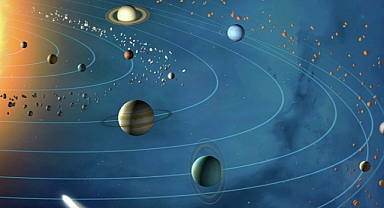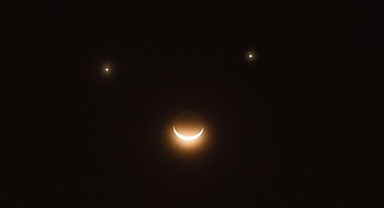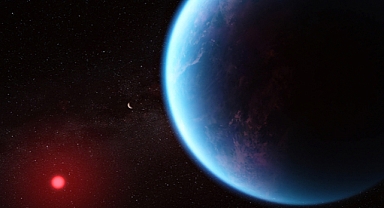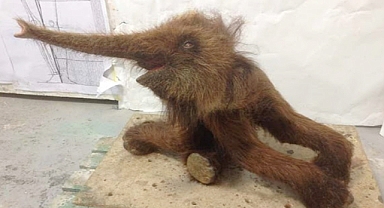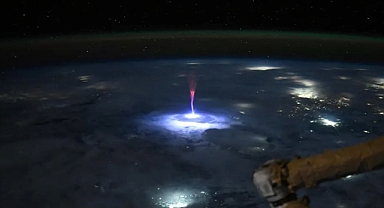How a Massive Ancient Asteroid Both Crushed and Revitalized LifeWhile devastating to Earth's primitive biosphere, new research suggests it also supplied the nutrients that early microbial life desperately needed to thrive.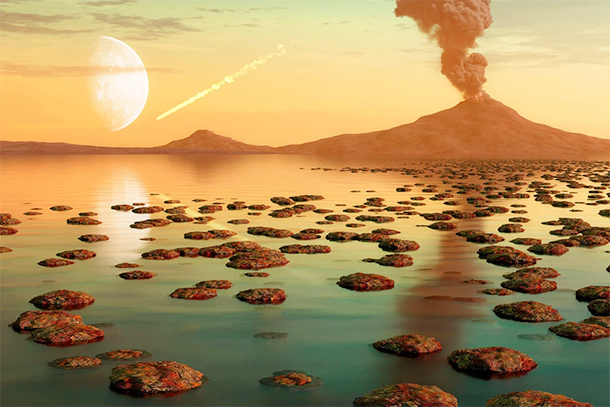 An artist’s illustration of Earth as it may have been during the Archean eon between 3.8 to 2.5 billion years ago, a time of violent asteroid impacts and volcanic eruptions. Back then, all life on Earth was microbial, with one of its few obvious signatures being microbe-built formations called stromatolites that littered shallow coastal waters. Mark Garlick/Science Photo Library/Alamy Stock PhotoA World Transformed by Impact and Recovery
An artist’s illustration of Earth as it may have been during the Archean eon between 3.8 to 2.5 billion years ago, a time of violent asteroid impacts and volcanic eruptions. Back then, all life on Earth was microbial, with one of its few obvious signatures being microbe-built formations called stromatolites that littered shallow coastal waters. Mark Garlick/Science Photo Library/Alamy Stock PhotoA World Transformed by Impact and Recovery
Research led by geologist Nadja Drabon at Harvard University reveals that besides vaporizing vast amounts of rock, the S2 impact triggered immense tsunamis and boiled the surface layers of the oceans. However, in the aftermath, the asteroid injected bioessential elements like phosphorus into Earth’s waters, spurring a bloom of simple microbial life. This paradoxical process of destruction and renewal bears some resemblance to the asteroid impact that ended the dinosaurs but paved the way for mammals—and eventually humans—to dominate Earth.Unlike the Yucatán impact, whose ecological damage lingered for millions of years, the chaotic aftermath of the S2 event appears to have been relatively short-lived. “Conditions were dreadful for maybe a few decades,” Drabon notes. “But after that, life bounced back remarkably fast.” This resilience suggests that early life on Earth was more robust in the face of catastrophic events than life forms today would be. Her findings, published in the Proceedings of the National Academy of Sciences USA, indicate that asteroid impacts may have played a more significant role in fostering life during Earth’s formative years than previously thought.The Face of an Alien Earth
If you could fly over Earth before the S2 asteroid hit, you would see a landscape far removed from what we know today. “It was essentially a water world,” says Andrew Knoll, a geobiologist at Harvard and co-author of the study. The oceans likely contained twice as much water as they do now, with a scattering of volcanic islands poking above the surface. Earth’s interior was still too hot to absorb moisture as efficiently as it does today, leaving most of the planet covered by shallow seas.Without large continents to erode and release minerals into rivers, Earth’s early oceans were starved of crucial nutrients such as phosphorus, copper, and nickel. Free oxygen was virtually nonexistent in the atmosphere, and only a fraction—perhaps 1 or 2 percent—of the life that exists today could be found in these primordial waters. This life consisted entirely of single-celled microbes, some of which relied on a primitive photosynthesis process. These microbes harnessed sunlight to extract electrons from iron dissolved in the water, enabling them to produce sugars from carbon dioxide. Yet even in these nutrient-poor waters, life persisted—though the top ocean layers, where light could penetrate, were barren biological deserts.Impact Layers Reveal a Chaotic Past
The image of a serene, uneventful early Earth changed dramatically thanks to discoveries in the 1980s and 1990s. In South Africa’s ancient rock formations, geologists Donald Lowe and Gary Byerly uncovered spherules—tiny, solidified droplets of molten rock—embedded in at least eight distinct layers. These spherules were created by the vaporized material ejected during massive asteroid impacts, evidence of cataclysms that occurred with startling regularity. Although the craters left by these impacts have eroded away, the spherule layers remain as a testament to the relentless bombardment Earth endured.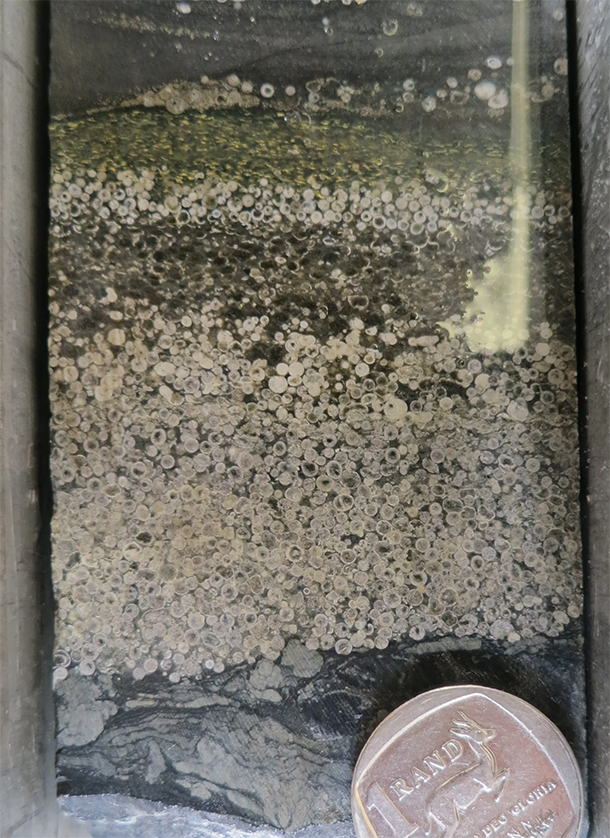 Spherules from an Archean impact layer, with a coin used for scale. Formed from molten debris that rained out from asteroid strikes, thick beds of these tiny orbs in Archean rocks are direct evidence for catastrophic impact events in Earth’s early history.Nadja Drabon
Spherules from an Archean impact layer, with a coin used for scale. Formed from molten debris that rained out from asteroid strikes, thick beds of these tiny orbs in Archean rocks are direct evidence for catastrophic impact events in Earth’s early history.Nadja Drabon
Lowe and Byerly estimated that between 3.5 and 3.2 billion years ago, Earth was hit by an asteroid larger than the dinosaur killer once every 15 million years. Some of these space rocks may have been up to 350 times as massive as the one that wiped out the dinosaurs. This constant bombardment played a significant role in shaping Earth’s environment and influencing its earliest life forms.The S2 impact not only disrupted ecosystems but also brought new opportunities for life. The nutrients released by the impact fueled microbial growth, potentially accelerating the development of Earth's biosphere. Despite the destruction, life proved remarkably adaptable, rebounding rapidly and evolving in the harsh aftermath of these ancient collisions.The Paradox of Creation and Destruction
The story of the S2 impact demonstrates how cosmic forces can shape life in unexpected ways. While it caused immense damage, it also primed Earth’s waters with the nutrients essential for survival and growth. This discovery challenges the long-held assumption that early Earth was a quiet place, suggesting instead that life has always been remarkably resilient in the face of catastrophe. Much like the asteroid impact that ended the reign of the dinosaurs but allowed mammals to flourish, the S2 event shows how destruction can sometimes act as a catalyst for new beginnings.
 An artist’s illustration of Earth as it may have been during the Archean eon between 3.8 to 2.5 billion years ago, a time of violent asteroid impacts and volcanic eruptions. Back then, all life on Earth was microbial, with one of its few obvious signatures being microbe-built formations called stromatolites that littered shallow coastal waters. Mark Garlick/Science Photo Library/Alamy Stock PhotoA World Transformed by Impact and Recovery
An artist’s illustration of Earth as it may have been during the Archean eon between 3.8 to 2.5 billion years ago, a time of violent asteroid impacts and volcanic eruptions. Back then, all life on Earth was microbial, with one of its few obvious signatures being microbe-built formations called stromatolites that littered shallow coastal waters. Mark Garlick/Science Photo Library/Alamy Stock PhotoA World Transformed by Impact and RecoveryResearch led by geologist Nadja Drabon at Harvard University reveals that besides vaporizing vast amounts of rock, the S2 impact triggered immense tsunamis and boiled the surface layers of the oceans. However, in the aftermath, the asteroid injected bioessential elements like phosphorus into Earth’s waters, spurring a bloom of simple microbial life. This paradoxical process of destruction and renewal bears some resemblance to the asteroid impact that ended the dinosaurs but paved the way for mammals—and eventually humans—to dominate Earth.Unlike the Yucatán impact, whose ecological damage lingered for millions of years, the chaotic aftermath of the S2 event appears to have been relatively short-lived. “Conditions were dreadful for maybe a few decades,” Drabon notes. “But after that, life bounced back remarkably fast.” This resilience suggests that early life on Earth was more robust in the face of catastrophic events than life forms today would be. Her findings, published in the Proceedings of the National Academy of Sciences USA, indicate that asteroid impacts may have played a more significant role in fostering life during Earth’s formative years than previously thought.The Face of an Alien Earth
If you could fly over Earth before the S2 asteroid hit, you would see a landscape far removed from what we know today. “It was essentially a water world,” says Andrew Knoll, a geobiologist at Harvard and co-author of the study. The oceans likely contained twice as much water as they do now, with a scattering of volcanic islands poking above the surface. Earth’s interior was still too hot to absorb moisture as efficiently as it does today, leaving most of the planet covered by shallow seas.Without large continents to erode and release minerals into rivers, Earth’s early oceans were starved of crucial nutrients such as phosphorus, copper, and nickel. Free oxygen was virtually nonexistent in the atmosphere, and only a fraction—perhaps 1 or 2 percent—of the life that exists today could be found in these primordial waters. This life consisted entirely of single-celled microbes, some of which relied on a primitive photosynthesis process. These microbes harnessed sunlight to extract electrons from iron dissolved in the water, enabling them to produce sugars from carbon dioxide. Yet even in these nutrient-poor waters, life persisted—though the top ocean layers, where light could penetrate, were barren biological deserts.Impact Layers Reveal a Chaotic Past
The image of a serene, uneventful early Earth changed dramatically thanks to discoveries in the 1980s and 1990s. In South Africa’s ancient rock formations, geologists Donald Lowe and Gary Byerly uncovered spherules—tiny, solidified droplets of molten rock—embedded in at least eight distinct layers. These spherules were created by the vaporized material ejected during massive asteroid impacts, evidence of cataclysms that occurred with startling regularity. Although the craters left by these impacts have eroded away, the spherule layers remain as a testament to the relentless bombardment Earth endured.
 Spherules from an Archean impact layer, with a coin used for scale. Formed from molten debris that rained out from asteroid strikes, thick beds of these tiny orbs in Archean rocks are direct evidence for catastrophic impact events in Earth’s early history.Nadja Drabon
Spherules from an Archean impact layer, with a coin used for scale. Formed from molten debris that rained out from asteroid strikes, thick beds of these tiny orbs in Archean rocks are direct evidence for catastrophic impact events in Earth’s early history.Nadja DrabonLowe and Byerly estimated that between 3.5 and 3.2 billion years ago, Earth was hit by an asteroid larger than the dinosaur killer once every 15 million years. Some of these space rocks may have been up to 350 times as massive as the one that wiped out the dinosaurs. This constant bombardment played a significant role in shaping Earth’s environment and influencing its earliest life forms.The S2 impact not only disrupted ecosystems but also brought new opportunities for life. The nutrients released by the impact fueled microbial growth, potentially accelerating the development of Earth's biosphere. Despite the destruction, life proved remarkably adaptable, rebounding rapidly and evolving in the harsh aftermath of these ancient collisions.The Paradox of Creation and Destruction
The story of the S2 impact demonstrates how cosmic forces can shape life in unexpected ways. While it caused immense damage, it also primed Earth’s waters with the nutrients essential for survival and growth. This discovery challenges the long-held assumption that early Earth was a quiet place, suggesting instead that life has always been remarkably resilient in the face of catastrophe. Much like the asteroid impact that ended the reign of the dinosaurs but allowed mammals to flourish, the S2 event shows how destruction can sometimes act as a catalyst for new beginnings.

